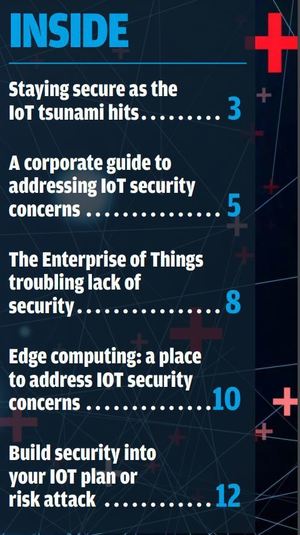IoT security: Why it’s your biggest nightmare
IoT has emerged from the explosive growth of connected devices in industrial verticals, the consumer arena and enterprise networks. The good news is that it has generated massive amounts of data that can be analyzed and acted on, resulting in operational efficiencies and new, revenue-generating services.
The bad news: It’s a security nightmare.
Vast IoT networks, transmitting data back to enterprise systems for analysis, have multiple points of weakness. The adoption of connected devices in every business sector is creating arguably the biggest tech-related security challenge ever.

Log in to Insider Pro or subscribe now to read our report on IoT security.
The numbers are mind-boggling. The number of connected devices globally could reach 30 billion by 2021, according IDC. That includes consumer items like watches, thermostats, and washing machines but also sensors on things like railway switches, telecom towers, and medical devices. All of this is in addition to sensors that have existed in manufacturing facilities for years.
IoT creates the ultimate security problem
IoT has produced the quintessential technology quandary: The value of such networks increases with the number of things that are connected, but so do security problems.
Because of the widespread adoption of connected devices, all business sectors have to be involved in related security issues, in consumer IoT, in enterprise IoT (EoT) and industrial IoT (IIoT).
One of the first rules of getting started in IoT is, if you are not sure whether your staff has a thorough understanding of the security issues involved, go no further until a full assessment is made.
What are IoT security problems and solutions?
IoT presents two basic challenges. First, IoT devices and systems represent valuable information and infrastructure: not just about consumer devices but buildings, vehicles, utilities and industrial machines, as well as information about users and their behavior. These are attractive assets for rogue nation-state actors and run-of-the-mill hackers alike. So, the number of potential targets as well as antagonists is virtually limitless, with no geographic boundary.
Secondly, the different types of devices, products, people, protocols, applications and computing systems involved means that there are multiple ways to attack any given network, along with related hacking techniques that can be used.
Fortunately, IoT has also given rise to best practices as enterprises of all stripes tackle the security challenges. So take heart. The challenges are great, but you can be helped by techniques for monitoring and managing endpoint devices, fast patching of system flaws, penetration testing, network gateways using the latest security software, and prioritization of exactly what needs to be secured.
To learn about best security practices for IoT, download “Inside IoT Security: Today’s big enterprise challenge”
READ MORE HERE



